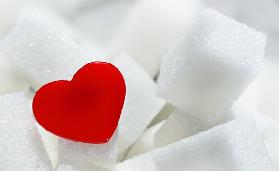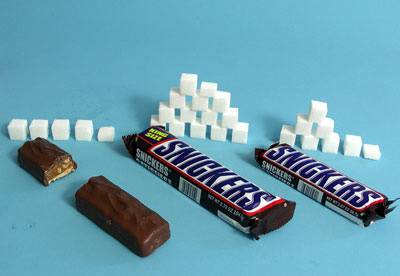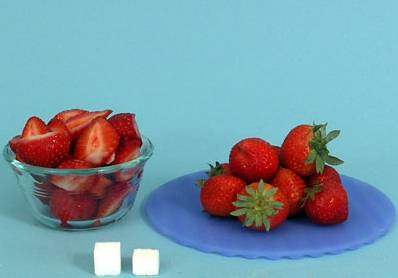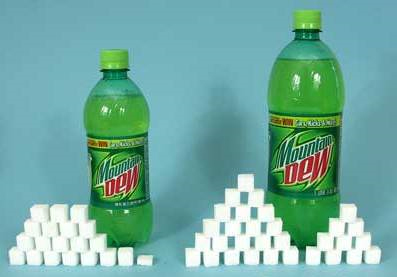
146 REASONS WHY SUGAR IS RUINING YOUR HEALTH:
By Nancy Appleton, Ph.D.
www.nancyappleton.com
1. Sugar can suppress the immune system.
2. Sugar upsets the mineral relationships in the body.
3. Sugar can cause hyperactivity, anxiety, difficulty concentrating, and crankiness in children.
4. Sugar can produce a significant rise in triglycerides.
5. Sugar contributes to the reduction in defense against bacterial infection (infectious diseases).
6. Sugar causes a loss of tissue elasticity and function, the more sugar you eat the more elasticity and function you loose.
7. Sugar reduces high density lipoproteins.
8. Sugar leads to chromium deficiency.
9. Sugar leads to cancer of the ovaries.
10. Sugar can increase fasting levels of glucose.

11. Sugar causes copper deficiency.
12. Sugar interferes with absorption of calcium and magnesium.
13. Sugar can weaken eyesight.
14. Sugar raises the level of a neurotransmitters: dopamine, serotonin, and norepinephrine.
15. Sugar can cause hypoglycemia.
16. Sugar can produce an acidic digestive tract.
17. Sugar can cause a rapid rise of adrenaline levels in children.
18. Sugar malabsorption is frequent in patients with functional bowel disease.
19. Sugar can cause premature aging.
20. Sugar can lead to alcoholism.

21. Sugar can cause tooth decay.
22. Sugar contributes to obesity
23. High intake of sugar increases the risk of Crohn’s disease, and ulcerative colitis.
24. Sugar can cause changes frequently found in person with gastric or duodenal ulcers.
25. Sugar can cause arthritis.
26. Sugar can cause asthma.
27. Sugar greatly assists the uncontrolled growth of Candida Albicans (yeast infections).
28. Sugar can cause gallstones.
29. Sugar can cause heart disease.
30. Sugar can cause appendicitis.

31. Sugar can cause multiple sclerosis.
32. Sugar can cause hemorrhoids.
33. Sugar can cause varicose veins.
34. Sugar can elevate glucose and insulin responses in oral contraceptive users.
35. Sugar can lead to periodontal disease.
36. Sugar can contribute to osteoporosis.
37. Sugar contributes to saliva acidity.
38. Sugar can cause a decrease in insulin sensitivity.
39. Sugar can lower the amount of Vitamin E (alpha-Tocopherol in the blood.
40. Sugar can decrease growth hormone.

41. Sugar can increase cholesterol.
42. Sugar can increase the systolic blood pressure.
43. Sugar can cause drowsiness and decreased activity in children.
44. High sugar intake increases advanced glycation end products (AGEs)(Sugar bound non-enzymatically to protein)
45. Sugar can interfere with the absorption of protein.
46. Sugar causes food allergies.
47. Sugar can contribute to diabetes.
48. Sugar can cause toxemia during pregnancy.
49. Sugar can contribute to eczema in children.
50. Sugar can cause cardiovascular disease.

51. Sugar can impair the structure of DNA
52. Sugar can change the structure of protein.
53. Sugar can make our skin age by changing the structure of collagen.
54. Sugar can cause cataracts.
55. Sugar can cause emphysema.
56. Sugar can cause atherosclerosis.
57. Sugar can promote an elevation of low density lipoproteins (LDL).
58. High sugar intake can impair the physiological homeostasis of many systems in the body.
59. Sugar lowers the enzymes ability to function.
60. Sugar intake is higher in people with Parkinson’s disease.

61. Sugar can cause a permanent altering the way the proteins act in the body.
62. Sugar can increase the size of the liver by making the liver cells divide.
63. Sugar can increase the amount of liver fat.
64. Sugar can increase kidney size and produce pathological changes in the kidney.
65. Sugar can damage the pancreas.
66. Sugar can increase the body’s fluid retention.
67. Sugar is enemy #1 of the bowel movement.
68. Sugar can cause myopia (nearsightedness).
69. Sugar can compromise the lining of the capillaries.
70. Sugar can make the tendons more brittle.

71. Sugar can cause headaches, including migraine.
72. Sugar plays a role in pancreatic cancer in women.
73. Sugar can adversely affect school children’s grades and cause learning disorders..
74. Sugar can cause an increase in delta, alpha, and theta brain waves.
75. Sugar can cause depression.
76. Sugar increases the risk of gastric cancer.
77. Sugar and cause dyspepsia (indigestion).
78. Sugar can increase your risk of getting gout.
79. Sugar can increase the levels of glucose in an oral glucose tolerance test over the ingestion of complex carbohydrates.
80. Sugar can increase the insulin responses in humans consuming high-sugar diets compared to low sugar diets.

81. High refined sugar diet reduces learning capacity.
82. Sugar can cause less effective functioning of two blood proteins, albumin, and lipoproteins, which may reduce the body’s ability to handle fat and cholesterol.
83. Sugar can contribute to Alzheimer’s disease.
84. Sugar can cause platelet adhesiveness.
85. Sugar can cause hormonal imbalance; some hormones become underactive and others become overactive.
86. Sugar can lead to the formation of kidney stones.
87. Sugar can lead to the hypothalamus to become highly sensitive to a large variety of stimuli.
88. Sugar can lead to dizziness.
89. Diets high in sugar can cause free radicals and oxidative stress.
90. High sucrose diets of subjects with peripheral vascular disease significantly increases platelet adhesion.

91. High sugar diet can lead to biliary tract cancer.
92. Sugar feeds cancer.
93. High sugar consumption of pregnant adolescents is associated with a twofold increased risk for delivering a small-for-gestational-age (SGA) infant.
94. High sugar consumption can lead to substantial decrease in gestation duration among adolescents.
95. Sugar slows food’s travel time through the gastrointestinal tract.
96. Sugar increases the concentration of bile acids in stools and bacterial enzymes in the colon. This can modify bile to produce cancer-causing compounds and colon cancer.
97. Sugar increases estradiol (the most potent form of naturally occurring estrogen) in men.
98. Sugar combines and destroys phosphatase, an enzyme, which makes the process of digestion more difficult.
99. Sugar can be a risk factor of gallbladder cancer.
100. Sugar is an addictive substance.

101. Sugar can be intoxicating, similar to alcohol.
102. Sugar can exacerbate PMS.
103. Sugar given to premature babies can affect the amount of carbon dioxide they produce.
104. Decrease in sugar intake can increase emotional stability.
105. The body changes sugar into 2 to 5 times more fat in the bloodstream than it does starch.
106. The rapid absorption of sugar promotes excessive food intake in obese subjects.
107. Sugar can worsen the symptoms of children with attention deficit hyperactivity disorder (ADHD).
108. Sugar adversely affects urinary electrolyte composition.
109. Sugar can slow down the ability of the adrenal glands to function.
110. Sugar has the potential of inducing abnormal metabolic processes in a normal healthy individual and to promote chronic degenerative diseases.

111. I.Vs (intravenous feedings) of sugar water can cut off oxygen to the brain.
112. High sucrose intake could be an important risk factor in lung cancer.
113. Sugar increases the risk of polio.
114. High sugar intake can cause epileptic seizures.
115. Sugar causes high blood pressure in obese people.
116. In Intensive Care Units, limiting sugar saves lives.
117. Sugar may induce cell death.
118. Sugar can increase the amount of food that you eat.
119. In juvenile rehabilitation camps, when children were put on a low sugar diet, there was a 44% drop in antisocial behavior.
120. Sugar can lead to prostrate cancer.

121. Sugar dehydrates newborns.
122. Sugar increases the estradiol in young men.
123. Sugar can cause low birth weight babies.
124. Greater consumption of refined sugar is associated with a worse outcome of schizophrenia
125. Sugar can raise homocysteine levels in the blood stream.
126. Sweet food items increase the risk of breast cancer.
127. Sugar is a risk factor in cancer of the small intestine.
128. Sugar may cause laryngeal cancer.
129. Sugar induces salt and water retention.
130. Sugar may contribute to mild memory loss.

131. As sugar increases in the diet of 10 years olds, there is a linear decrease in the intake of many essential nutrients.
132. Sugar can increase the total amount of food consumed.
133. Exposing a newborn to sugar results in a heightened preference for sucrose relative to water at 6 months and 2 years of age.
134. Sugar causes constipation.
135. Sugar causes varicous veins.
136. Sugar can cause brain decay in prediabetic and diabetic women.
137. Sugar can increase the risk of stomach cancer.
138. Sugar can cause metabolic syndrome.
139. Sugar ingestion by pregnant women increases neural tube defects in embryos.
140. Sugar can be a factor in asthma.

141. The higher the sugar consumption the more chances of getting irritable bowel syndrome.
142. Sugar could affect central reward systems.
143. Sugar can cause cancer of the rectum.
144. Sugar can cause endometrial cancer.
145. Sugar can cause renal (kidney) cell carcinoma.
146. Sugar can cause liver tumors.




 Running is the simplest, easiest and enjoyable way to get and stay in shape. It contributes to the good functioning of all our organs and helps our body to better deal with fatigue.
Running is the simplest, easiest and enjoyable way to get and stay in shape. It contributes to the good functioning of all our organs and helps our body to better deal with fatigue.

 “To run a good marathon, those “water/food” stations are essential from the first kilometers. Don’t wait to be hungry or thirsty, it will be too late”
“To run a good marathon, those “water/food” stations are essential from the first kilometers. Don’t wait to be hungry or thirsty, it will be too late”
























